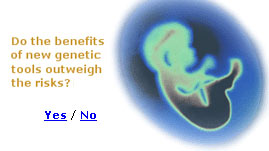The map of the human genome has provided far more than a simple list of the 3 billion letters that make up our genetic code. Scientists and doctors have begun to understand what certain groups of these letters -- our genes -- actually do. By the turn of the millennium, scientists had identified the genes involved in determining hundreds of human traits: a person's gender, their hair and eye color, the development of their taste receptors, and so on. More importantly, scientists have also located dozens of genes that cause disease.
The link between genes and physical traits has allowed doctors and parents concerned about the health of their unborn children to screen for specific genes, especially those that cause disease. The capability of genetic tests, which screen for disease-causing genes in adult couples and/or their embryos or fetuses will likely improve over time.
Many people, however, are concerned that our ability to test for particular genes -- especially when that ability may one day lead to
altering those genes -- is simply too risky. They argue that the attempt by science to change the genetic make-up of humans may not stop with genes that cause disease. Those genes linked to any and all traits deemed "troublesome" by some -- shortness, baldness, below-average intellect, curly hair, and so on -- could one day be subject to genetic alteration, they say. And while advocates of human genetic manipulation might cheer the removal of many traits from the population, critics argue that accomplishing such a feat could eliminate the variability that makes us human.


 Loading Standards
Loading Standards Teachers' Domain is proud to be a Pathways portal to the National Science Digital Library.
Teachers' Domain is proud to be a Pathways portal to the National Science Digital Library.
